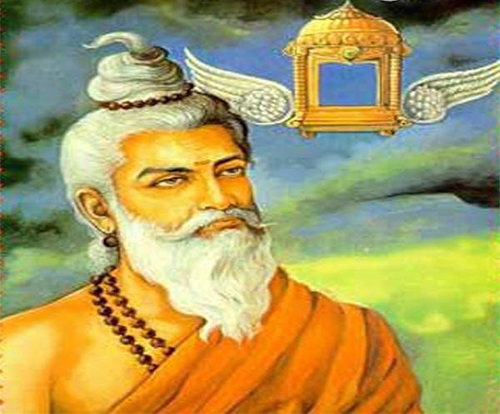


Sage Bhardwaj, born in the beginning of Treta Yuga, was a contemporary of King Anshuman, born in the 43rd generation of the Ikshvaku dynasty. These clans were the descendants of Angira Rishi, the Manas son of Brahma. There have been many great Vibhutis of them, in which the main ones are Vitath Bhardwaj, Kanva, Vamdev, Yavakrit, Dronacharya Ashwatthama and Patanjali. Sage Bharadwaj was the son of Brihaspati. Brihaspati was the Rajguru of Vaishali. King Marutta of Vaishali brought up Bhardwaj. According to the Matsya, Vayu Puranas, Bhardwaj was brought up by the god Marut. None of the sons of Puru dynasty, king Bharata was eligible to become the king. King Marutt handed over the promising child, Bharadwaj to Bharat. After being adopted by Bharata, Bharadwaja was called a Kshatriya Brahmin. After the death of King Bharat, Bhardwaj went to the forest for penance by making his son Vitath or Vidthin as the ruler. According to the Aitareya Brahmana, Bhardwaj was tall, lean, ascetic, learned and lived a long life. In Arthveda and Brahmin-texts, Bhardwaj has been called Vedic Sukta seer. He composed many hymns of the sixth division of Rigveda. That’s why he has been called the scholar of his era. The sage who was the collector of Veda mantras was decorated with the title of Vyasa. Bhardwaj is also famous as Vyakarancharya. He got the knowledge of this scripture from Indra. Indra learned grammar from Brihaspati and Brihaspati from Brahma. According to Samveda, Brahma was the original author of grammar. Famous grammarians Panini and Patanjali have also quoted many rules from Bhardwaj. Sage Bhardwaj had done important work in Ayurveda as well. The famous Vaidya Dhanvantari was his disciple. Bhardwaj was also the author of a Kalpasutra. The Kalpasutra consists of three parts, the Srauta Sutras, the Dharma-Sutras and the Grihya Sutras. Bhardwaj Samhita, Bhardwaj Smriti, Vastu Tattva and four stotras of Vedas are also considered to be his creations.
Vitath or Vidthin:
Among the descendants of Bhardwaj, those who sat on the throne were called Pauravas. Bhuvamanyu was the mighty son of Vitatha. His eldest son Brihakshatra became the king and the other four sons Mahavirya, Shunhotra, Nara and Garga became Brahmins. Among the descendants of Vidthin, Gargya Sankriti, Urukshat, Pushkar and Kavya etc. became famous sages. All these are called Vaidthin. Being associated with both Brahmin and Kshatriya clans, he is also called Dwamushyayan. Hasti became the king in Vaidthin dynasty. He established the city of Hastinapur. His three sons were Ajmeedh, Dwimeedh and Purumeedh. Sage Kanva was born from Keshini, the wife of Ajmidh, who composed most of the Suktas of the first Mandala of the Rigveda. According to Bhagwat, he was one of the fifteen disciples of Yajnavalkya. He was the originator of the Kanva branch of Yajurveda. Kanva Upanishad Kanva Niti, Kanva Smriti etc. books are popular by his name. The descendants of Kanva were called Kanvayan Brahmins. Krit, a descendant of Dwimidh, learned Yoga Vidya from Hiranya named Kaushalya and composed twenty-four codes of Smritis. Mudgal became the king of North Panchal country in the sixth generation of Ajmeed. His eldest son became a Brahmin. His grandson was Divodas and granddaughter Ahalya. Ahalya was blessed with Gautama.


Hinduism is a religion that is alive for thousands of years. It is such a tradition that was born in the Indian subcontinent and shaped the Indian culture. Hinduism is not only a religion but also an integral identity of the majority of Indians.
Read more